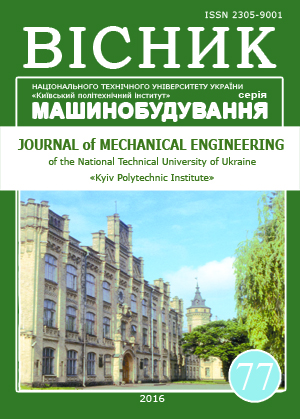EFFECT OF DROPLETS CONVECTIVE HEATING AND THEIR EVAPORATION ON THE SHIELDING PROPERTIES OF FIRE-FIGHTING WATER CURTAIN
DOI:
https://doi.org/10.20535/2305-9001.2016.77.69968Keywords:
fire-fighting water curtain, convective heat and mass exchange, droplets evaporation.Abstract
Purpose. This work represents further development of earlier received results of simulation of water curtains used as fire protection walls. Subject of the theoretical analysis is the flat fan sprays which flow from the slot-hole sprinkler. The central objective of the study is theoretical research of processes of droplets convective heating and their evaporation in heated air near the fire seat and their influence on the shielding properties of a fire-fighting water curtain.
Approach. In this study the earlier published literary data are applied to fulfill the calculations. The calculated formula allowed to have received numerical results for graphic dependence of droplet equilibrium temperature on air temperature. Other calculated formulae allowed to have executed calculations of the droplet evaporation time and of the time of droplet flight along an axis of a water curtain. According to the executed calculations, for typical parameters of water curtain the droplets heating and their evaporation owing to heat convection with hot air have no significant effect on the shielding properties of fire-fighting water curtain.
Findings. Application of this formula to earlier developed mathematical model of thermal shielding allowed expanding its opportunities for practical use. This model can be used for designing of water curtains of fire-prevention appointment, and also for definition of optimum modes of their operation.References
Zharov, A., Zarhin, A. and Mitrofanova, M. (2006) Drenchernye zavesy: teorija i praktika [Drencher curtains: theory and practice], BDI, No. 5 (68), pp. 24-28, available at: http://mx1.algoritm.org/arch/?id=22&a=547 (Accessed 20 May 2016).
Sobeshhans'kyj, D.I., Anohin, G.O. and Sklyzkova, L.A. (2010), “Water curtains in systems of ensuring fire-prevention protection of objects of different function” [Vodjani zavisy v systemah zabezpechennja protypozhezhnogo zahystu ob’jektiv riznogo pryznachennja], Naukovyj visnyk UkrNDIPB, No. 2 (22), pp. 148-153.
“Fire-fighting water curtain” [Protivopozharnaja vodjanaja zavesa], available at: http://www.bikoms.ru/dictionary/p/protivopozharnaja-vodjanaja-zavesa/ , (Accessed 20 May 2016).
Gant, S.E., (2006), CFD “Modeling of Water Spray Barriers”, Health and Safety Laboratory, UK, Report HSL, no 79.
Meroney, R.N. (2012), “CFD modeling of water spray interaction with dense gas plumes”, Atmospheric Environment, vol. 54, pp. 706-713.
Cong, B.H., Liao, G.X. and Chow, W.K. (2005), “Review of modeling fire suppression by water sprays by computational fluid dynamics”, International Journal on Engineering Performance-Based Fire Codes, vol. 7, No. 2, pp. 35-56.
Meshman, L.M. (2002), Proektirovanie vodjanyh i pennyh avtomaticheskih ustanovok pozharotushenija [Projection of water and foamy automatic installations of a firefighting], N.P. Kopylov. ed. by VNIIPO, Moskow, Russia.
Stas, S.V. (2011), The analysis of jet streams generation system which are applied in fire-fighting. [Analiz systemy generuvannya strumy`nny`x potokiv, shho zastosovuyut`sya v pozhezhogasinni], Visnyk Nacionalnogo texnichnogo universytetu Ukrayiny «Kyivskyj politexnichnyj instytut», ser. Mashynobuduvannya, No. 63, pp. 240-243.
Vinogradov, A.G. (2014), “Pozharovzryvobezopasnost”, Metodika rascheta jekranirujushhih svojstv vodjanyh zaves [Calculation method of water curtain shielding properties], vol. 23, No. 1, pp. 45-57.
Vynogradov, A.G. (2013), “Calculation method of water curtain parameters on basis of the submerged jet theory” [Metodyka rozrahunkiv parametriv vodjanyh zavis na osnovi teorii' zatoplenyh strumeniv], Naukovyj visnyk UkrNDIPB, No. 2 (28), pp. 127-139.
Lukanin, V.N., Shatrov M.G. et al. (1999), Teplotehnika [Heat engineering], Vysshaja shkola, Moscow, Russia.
Martens, L.K. (ed.) (1928), AO “Sovetskaja jenciklopedija”, Tehnicheskaja jenciklopedija [Technical encyclopedia], vol.4, Moskow, Russia.
Vukalovich, M.P. (1967), Teplofizicheskie svojstva vody i vodjanogo para [Thermal properties of water and steam], Mashinostroenie, Moskow, Russia.
Grigor'ev, I.S. and Mejlihov, E.Z. (ed.), (1991), Fizicheskie velichiny: Spravochnik [Physical quantities: Reference book], Jenergoatomizdat, Moskow, Russia.
Fuks, N.A. (1958), Isparenie i rost kapel' v gazoobraznoj srede [Evaporation and body height of drops in the gaseous environment], Izdatel'stvo AN SSSR, Moskow, Russia.
Vinogradov, A.G. (2011), “Pozharovzryvobezopasnost” Uchet vtorichnyh vozdushnyh potokov pri matematicheskom modelirovanii raspylennyh vodjanyh struj [Consideration of secondary air streams at mathematical modeling of the atomized water jets], vol. 20, no. 2, pp. 29-33.

